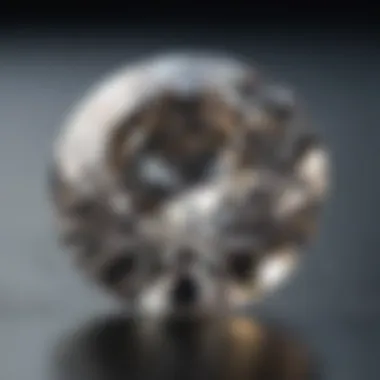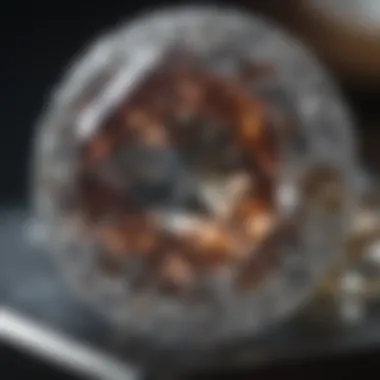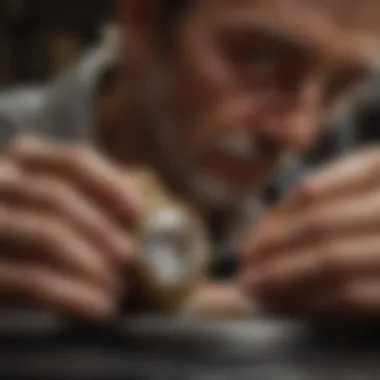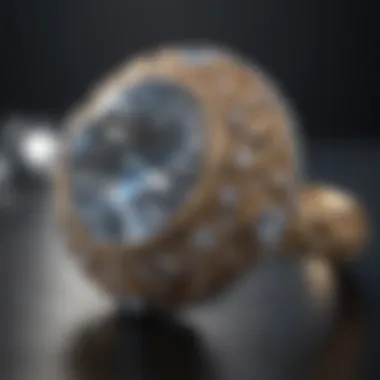Unveiling the Charm of Old Euro Diamonds


Intro
In recent years, there has been a growing interest in Old Euro Diamonds. These gemstones possess a unique charm that stems from their historical context and distinctive features. Understanding their allure requires a deep dive into their characteristics and the factors that shape their market value.
Old Euro Diamonds were cut using techniques prevalent in the late 19th and early 20th centuries. Their craftsmanship reflects a time when the art of diamond cutting was more focused on maximizing individual character rather than adhering strictly to modern grading standards. This captivating narrative includes not only the visual elements of the stones but also their formation processes and the cultural significance they hold.
For gemstone enthusiasts, collectors, and jewelry designers, it is valuable to explore the facets that contribute to the desirability of Old Euro Diamonds. This exploration involves asking questions such as: What makes them different from other diamonds? How does their history influence current market trends? And importantly, what ethical considerations surround their sourcing?
To fully appreciate Old Euro Diamonds, one must engage with their geological origins and the cultural impacts they have had over the years. The following sections will delve into these various aspects, providing readers with a comprehensive understanding of Old Euro Diamonds and enriching their knowledge of the gemstone industry.
Preamble to Old Euro Diamonds
Old Euro Diamonds are not just gemstones; they are a fascinating intersection of history, craftsmanship, and allure. Understanding these diamonds enriches one's knowledge of both the gemstone market and the artistry of jewelry design. In this section, we will explore their definition and historical context, which lays the groundwork for appreciating their significance in modern jewelry.
Definition and Historical Context
Old European cut diamonds, often referred to simply as Old Euro Diamonds, are characterized by their round shape and the way they manage light reflection. This cut emerged in the late 19th century to early 20th century, marking a significant period in the history of diamond cutting. The cut is known for its high crown and large table, which enhances its brilliance compared to earlier styles.
Historically, these diamonds were created before the advent of modern cutting techniques, making them unique in comparison to contemporary diamonds. The craftsmanship of Old Euro Diamonds reflects both the technological limitations of the period and the artisan's skill. Because of this, they often display unique imperfections and character that modern diamonds lack. Their circular outline often evokes a sense of nostalgia and charm.
The Evolution of Diamond Cutting Techniques
The evolution of diamond cutting has been drastic over the centuries. Initially, diamonds were not cut at all; they were used in their natural state, often in the form of uncut rough stones. With the advent of cutting techniques in Europe during the Renaissance, jewelers began experimenting with shapes that would maximize a diamond's brilliance and play of light.
The Old European cut represents a transitional phase in this journey of innovation. After the Old Mine cut, which was prevalent during the 18th century, the Old European cut sought to improve upon its predecessors. Jewelers aimed to increase sparkle and minimize inclusions through careful shaping. This cut featured larger facets compared to earlier methods, which allowed for better light performance.
Now, discerning collectors and jewelry enthusiasts appreciate Old Euro Diamonds not only for their aesthetic qualities but also for the historical narrative they carry. Each stone encapsulates a story—from the miner who unearthed it to the artisan who crafted it. In the current market, these diamonds are valued not only for their physical properties but also for their intrinsic historical significance.
"Old Euro Diamonds connect the wearer to a rich heritage of artistry and tradition, offering a glimpse into the past while gracing modern jewelry with vintage charm."
In summary, this section provides foundational knowledge regarding Old Euro Diamonds, leading into further exploration of their physical characteristics, mining processes, and cultural importance. Understanding these elements is essential for anyone serious about gemology and jewelry design.
Physical Characteristics of Old Euro Diamonds
The study of physical characteristics of Old Euro Diamonds is critical for understanding their unique appeal and value within the gemstone market. These diamonds possess distinct features that differentiate them from modern cut stones. In this section, we will explore key attributes such as cut, color, clarity, and carat weight. This examination not only enhances our appreciation for these gems but also provides insights for collectors and jewelry designers in making informed decisions.
Cut, Color, and Clarity
The cut of a diamond is often regarded as one of its most significant characteristics. Old Euro Diamonds typically showcase a cushion shape with a rounded outline. This particular cut provides a different play of light compared to modern brilliant cuts. The way light interacts with the facets gives Old Euro Diamonds a captivating and warm glow. Collectors often prefer these diamonds for their individual charm.
Color is another essential factor. Old Euro Diamonds can range from colorless to slightly tinted hues, with light yellow tones being common. This slight warmth often enhances their vintage appeal. The rarity of a completely colorless diamond is reflected in its valuation. However, many collectors appreciate the character brought by shades of yellow.
Clarity in diamonds refers to the presence of internal or external flaws, known as inclusions and blemishes. Old Euro Diamonds usually possess inclusions that can tell a story of their formation. Jewelers and collectors often value these unique inclusions, recognizing them not merely as flaws but as markers of authenticity and age.
Carat Weight and Its Implications
Carat weight is critical in the valuation of diamonds. Old Euro Diamonds tend to be higher in carat weight compared to their modern counterparts. A larger stone often evokes prestige and rarity. For many collectors, the size of the diamond is a crucial factor that influences their purchase.
However, carat weight alone does not determine value; it must be considered alongside cut, color, and clarity. The market trends indicate that buyers are increasingly appreciating larger Old Euro Diamonds despite potential inclusions or color variations.


"Old Euro Diamonds are not just stones; they are pieces of history that reflect the artistry and techniques of their time."
By grasping the complexities of cut, color, clarity, and carat weight, enthusiasts gain the ability to make insightful choices in collection and design.
The Mining and Formation of Old Euro Diamonds
The mining and formation of Old Euro Diamonds is a crucial aspect in understanding their allure and appeal. The story of these gems begins deep within the Earth’s crust, where specific geological conditions create the possibility for diamonds to form. This section will explore their geological origins and the various extraction processes involved in bringing them to the surface.
Geological Origins
Old Euro Diamonds trace their origins to the carbon-rich environments found in the Earth’s mantle. The formation happens at depths of approximately 150 to 200 kilometers. Under extreme heat and pressure, carbon atoms bond in a crystallized structure, creating diamonds. Over millions of years, tectonic movements can bring these diamonds closer to the surface, often through volcanic eruptions.
Key locations such as the Kimberlite pipes in South Africa, Russia, and Canada are known for producing these diamonds. The unique volcanic activity within these regions has facilitated the transportation of diamonds from deep geological layers. Importantly, the geological conditions that yield Old Euro Diamonds are relatively rare, making these gems especially valuable.
Extraction Processes and Methods
The extraction of Old Euro Diamonds is just as significant as their geological formation. Different methods are employed based on the location and type of deposit. The primary extraction methods include:
- Open-pit mining: This method is used when diamonds are found near the surface. Large quantities of earth are removed, and the diamonds are extracted from the ore.
- Underground mining: In situations where diamonds are deeply embedded, this method involves creating tunnels and mining shafts. Highly skilled miners work to ensure safety while accessing deeper layers.
- Alluvial mining: This is a less conventional method where diamonds that have weathered out of their original location are extracted from riverbeds or ocean bars. Here, water plays a key role in sorting and revealing these precious stones.
In every extraction method, there are significant considerations regarding the impact on the surroundings. Modern mining companies often face scrutiny over their environmental practices, making ethical sourcing even more relevant.
"The journey of a diamond from deep within the Earth's mantle to the consumer is a complex process, reflecting the value of both the gem and the resources involved in its supply chain."
Understanding these extraction processes provides vital context to the value placed on Old Euro Diamonds. They are not merely beautiful stones but represent significant geological and human effort, which enhances their desirability among collectors and enthusiasts alike.
Cultural Significance of Old Euro Diamonds
The allure of Old Euro Diamonds extends far beyond their physical characteristics. Their cultural significance plays a crucial role in the fascination many people have with these unique gems. Understanding this cultural context offers deeper insights into why collectors and jewelry enthusiasts are drawn to these diamonds.
Historical Use in Jewelry
Old Euro Diamonds have a rich history that intertwines with various cultural moments and artistic movements. Since their emergence in the early 19th century, these diamonds have been favored in high-end jewelry design.
Traditionally, they were cut by hand, creating a unique sparkle that differed significantly from modern laser-cut diamonds. This hand-cutting technique allowed for a more organic and distinctive aesthetic. Historical jewelry pieces, particularly from the Victorian and Edwardian eras, often incorporate Old Euro Diamonds, imbuing them with stories of love, engagement, or family heritage. Their use in antique settings is prevalent, often accompanied by intricate metalwork and design. This showcases the craftsmanship of the era, adding value to both the diamonds and the pieces they adorn.
Moreover, Old Euro Diamonds represent the luxury and status of their wearers. In many cultures, diamonds symbolize wealth and success, thus enhancing their desirability. These stones have graced royal crowns and iconic jewelry collections over the centuries. Such historical usage emphasizes their enduring tradition and cultural relevance today. For collectors, owning an Old Euro Diamond is akin to possessing a piece of history, linking them to past generations.
Symbolism and Traditions
Old Euro Diamonds carry a wealth of symbolism that resonates with various traditions. They have often been associated with eternal love and commitment, making them a popular choice for engagement rings. This symbolism is deeply ingrained in many cultures, with diamonds embodying the idea of lasting bonds.
Additionally, these diamonds have been linked to power and prestige. In many societies, they serve as a status symbol, reflecting affluence and taste. The very act of wearing such a stone can convey a message about one��’s social standing.
In some cultures, specific traditions involve presenting diamonds during significant life events, such as weddings or anniversaries. These customs link Old Euro Diamonds to important milestones, further enhancing their cultural significance.
"Diamonds are more than mere gemstones; they encapsulate stories, traditions, and the essence of relationships across time."
Overall, the cultural significance of Old Euro Diamonds is multi-faceted, with historical applications in jewelry and rich symbolic meanings that continue to resonate today. This connection makes them not just accessories but components of personal and collective narratives.
Valuation and Market Trends


The valuation of Old Euro Diamonds is a critical component of understanding their appeal and market viability. These diamonds hold a special place not only in the eyes of collectors but also in the luxury jewelry market. Their historical significance, combined with distinct physical characteristics, plays a significant role in how they are valued. Knowing the trends in this sector can help enthusiasts and investors make informed decisions about purchases, collections, and potential investments.
Factors Influencing Value
Several factors converge to shape the value of Old Euro Diamonds. These diamonds tend to be valued based on a few key attributes:
- Cut Quality: The craftsmanship of the cut greatly affects the sparkle and overall beauty. Old Euro Diamonds typically feature a round or cushion cut, allowing for a mix of brilliance and vintage style.
- Color and Clarity: The presence of color and inclusions impacts valuation. Old Euro Diamonds that are colorless or exhibit minimal inclusions are generally more sought after. Spectrum ranges influence how light interacts with the stone, contributing to its allure.
- Carat Weight: As with all diamonds, larger stones often command higher prices. However, the rise of appreciation for smaller, high-quality stones cannot be overlooked.
- Historical Background: Provenance plays a role too. Diamonds with a notable history, such as ownership by celebrities or ties to significant events, tend to increase in value.
- Market Fluctuations: Economic conditions can impact overall demand and pricing. As luxury items, diamonds can experience price volatility depending on consumer confidence and market stability.
Understanding these factors can help one navigate the complex landscape of diamond valuation effectively.
Current Market Demand and Trends
Currently, the market for Old Euro Diamonds is experiencing a resurgence in interest. Many collectors and jewelry designers seek to incorporate these vintage pieces into modern designs. This demand is driven by:
- Trend Toward Vintage Jewelry: Many consumers are gravitating toward unique and vintage items rather than mass-produced jewelry. Old Euro Diamonds fit perfectly into this trend, offering character and history.
- Sustainability and Ethical Concerns: There is an increasing awareness surrounding ethical sourcing. Many buyers prefer diamonds with a clear lineage and ethical extraction practices rather than newly mined stones.
- Personalization and Individualism: In contemporary fashion, personalized and distinct pieces are highly valued. Old Euro Diamonds, with their unique characteristics, provide an opportunity for bespoke jewelry designs that reflect individual styles.
While the market adapts, it is crucial for buyers to stay informed about these shifting trends.
"The allure of Old Euro Diamonds lies not just in their aesthetic appeal but within their storied past, enshrining art and craftsmanship that transcends time."
In summary, the valuation and market trends surrounding Old Euro Diamonds reflect a blend of historical significance and modern consumer preferences. Awareness of the key factors influencing valuation can empower enthusiasts to make informed choices as they explore this fascinating segment of the jewelry market.
Ethical Sourcing and Environmental Impact
The conversation surrounding Old Euro Diamonds inevitably leads to the critical topics of ethical sourcing and environmental impact. As awareness grows concerning the consequences of diamond mining, discerning buyers are increasingly considering the sources of their gems. This section aims to elaborate on why ethical sourcing and environmental considerations are paramount for the longevity of the diamond industry and the preservation of our planet.
Understanding Ethical Sourcing
Ethical sourcing refers to the responsible acquisition of materials, ensuring they are produced with fairness and minimal harm to people and the environment. This approach is particularly significant in the diamond industry, where the term "blood diamond" can evoke grim images of conflict and exploitation.
Old Euro Diamonds, often obtained from mines operating long before modern regulations were established, must now be evaluated within an ethical framework. Collectors should seek documentation proving that their diamonds come from sources that respect human rights and environmental standards. This can include:
- Certification from recognized organizations, such as the Kimberley Process,
- Transparency regarding the mining producing countries,
- Information on the social impacts on local communities.
By prioritizing ethical sourcing, buyers not only contribute to just practices but also enhance the value of their stones. Gems perceived as ethically sourced often possess higher market desirability.
Environmental Considerations in Diamond Mining
Diamond mining has significant implications for the environment. From habitat destruction to water contamination, the methods employed in extraction can lead to substantial ecological harm. As such, understanding these impacts is crucial. Here are some key environmental considerations:
- Habitat Destruction: Traditional mining methods can erase substantial areas of natural habitat, leading to loss of biodiversity. This can have ripple effects on local ecosystems, disrupting flora and fauna.
- Water Usage and Pollution: The diamond mining process can consume large amounts of water and introduce pollutants into local waterways. As water is essential for both ecosystem health and human communities, these practices raise substantial ethical issues.
- Carbon Footprint: Mining activities contribute to greenhouse gas emissions. The diamond industry needs to assess its overall environmental impact to promote sustainability.
"The responsibility to source diamonds ethically transcends profit margins, delving into the realms of human rights and ecological stewardship."
Old Euro Diamonds in Contemporary Jewelry
Old Euro Diamonds hold a distinguished place in the landscape of contemporary jewelry. Their unique characteristics and historical significance make them sought-after gems for modern jewelry designers and enthusiasts alike. The rise of vintage and antique styles in today’s fashion has propelled these diamonds into the spotlight, giving enthusiasts a reason to appreciate their charm further.
In jewelry design, Old Euro Diamonds are valued for their distinct cut and ancient craftsmanship. Unlike modern brilliant cuts, the Old Euro cut features a more romantic, softer profile that captures light differently. This uniqueness allows designers to create pieces that elegantly highlight the diamond's brilliance while incorporating a sense of history.
Design Trends Featuring Old Euro Diamonds


The integration of Old Euro Diamonds into design trends emphasizes the desire for individuality. Many jewelry enthusiasts are moving away from mass-produced designs in favor of one-of-a-kind pieces. Here are some notable trends:
- Vintage Revivals: Many contemporary designs draw inspiration from historical jewelry, particularly from the Art Deco and Edwardian periods. Old Euro Diamonds fit seamlessly into these designs, enhancing their authenticity.
- Minimalism Meets Antique: Clean, minimalist settings paired with Old Euro Diamonds are becoming popular. The focus is on the diamond itself, allowing its character to shine without distraction.
- Stackable Jewelry: Stacking rings featuring Old Euro Diamonds creates a personalized look, allowing for both a contemporary twist and a nod to tradition.
Unique Settings and Pairings
When it comes to settings, Old Euro Diamonds can be showcased in various styles, which enhance their vintage appeal:
- Cluster Settings: Traditional cluster settings around a central Old Euro Diamond highlight its size and sparkle, while adding a layer of vintage flair.
- Gallery Settings: A gallery setting allows for a unique view of the diamond from different angles. This is particularly effective with Old Euro cuts, as their cut can create captivating visual effects.
- Mixed Materials: Pairing Old Euro Diamonds with modern materials such as titanium or alternative metals provides a contrast that emphasizes their historical elegance.
"The allure of Old Euro Diamonds lies in their distinctive characteristics and the stories they tell through their intricate design and craftsmanship."
Caring for Old Euro Diamonds
Caring for Old Euro Diamonds is crucial for maintaining their brilliance and integrity. These gemstones are known for their historical significance and unique characteristics, and proper care ensures that they retain their charm over time. This section will cover essential maintenance tips and handling recommendations, enabling enthusiasts and collectors to preserve their investments effectively.
Maintenance Tips for Longevity
Maintaining the shine and quality of Old Euro Diamonds requires regular attention. Here are some key tips to keep these gemstones in optimal condition:
- Regular Cleaning: Use a gentle cleaning solution alongside a soft brush to remove dust and dirt. It's best to perform this monthly.
- Avoid Harsh Chemicals: Stay away from harsh detergents and abrasive materials that can scratch or damage the diamond surface.
- Professional Inspections: Consider having the diamond inspected by a jeweler at least once a year to check for any damage or loose settings.
By following these practices, owners can ensure the longevity of their Old Euro Diamonds and make them shine for generations.
Handling and Storage Recommendations
Proper handling and storage can greatly reduce the risk of damage to Old Euro Diamonds. Consider these recommendations:
- Separate Storage: Store diamonds separately from other jewelry to prevent scratches. Use a soft pouch or a lined jewelry box specifically for this purpose.
- Limit Exposure to Light: Although diamonds are durable, prolonged exposure to direct sunlight can lead to discoloration over time. Keep them in a cooler, dark space for preservation.
- Mindful Wearing: When wearing the diamond for special occasions, be cautious of settings or situations that could cause stress on the stone. Avoid wearing during physical activities or when working with chemicals.
"Proper care enhances not only the beauty of Old Euro Diamonds but also their value over time."
By adopting these practices, you can safeguard your Old Euro Diamonds and ensure they remain a treasured part of your collection.
Future of Old Euro Diamonds
The future of Old Euro Diamonds is a topic of great relevance in the context of this article. As these historic gemstones continue to capture the interest of collectors and jewelry designers, understanding their market trajectory becomes essential. Several factors influence this future, ranging from evolving consumer preferences to advances in diamond sourcing and cutting technology. In this section, we explore how these elements shape the fate of Old Euro Diamonds.
Predictions for the Market
Several market predictions indicate a promising outlook for Old Euro Diamonds. Many collectors view these stones as not only valuable treasures but also as wise investments. The rarity of Old Euro Diamonds contributes significantly to their increasing demand. As newer generations become interested in vintage styles, the appeal of Old Euro Diamonds will likely grow.
Some key points to consider:
- Rarity: As mining becomes constrained, the supply of Old Euro diamonds will dwindle, further increasing their value.
- Investment Demand: Investors are increasingly drawn to these diamonds as tangible assets, pushing their prices upward.
- Vintage Trends: Many buyers seek unique pieces that tell a story, further driving interest in Old Euro diamonds.
The market is projected to show steady growth as long as these factors remain intact.
Technological Innovations Impacting the Industry
Technological advancements have revolutionized various industries, and diamond sales are no exception. Old Euro diamonds may also benefit from these innovations in the following ways:
- Enhanced Grading Techniques: With superior technology, grading for cut, color, and clarity has become more standardized and precise, ensuring that Old Euro Diamonds are evaluated accurately.
- Sustainable Mining Methods: Innovations in eco-friendly mining techniques could improve the ethical sourcing of Old Euro Diamonds, appealing to environmentally conscious consumers.
- 3D Modeling: This technology enables designers to create unique settings that highlight the distinct beauty of Old Euro Diamonds, allowing for greater artistic expression in jewelry designs.
"Technological advancements not only elevate the market's integrity but also open fresh avenues for creative expression in jewelry design."
In summary, the future of Old Euro Diamonds appears promising. Driven by a combination of rarity, evolving consumer trends, and continuous advancements in technology, these classic gems are set to maintain their allure in the marketplace.



